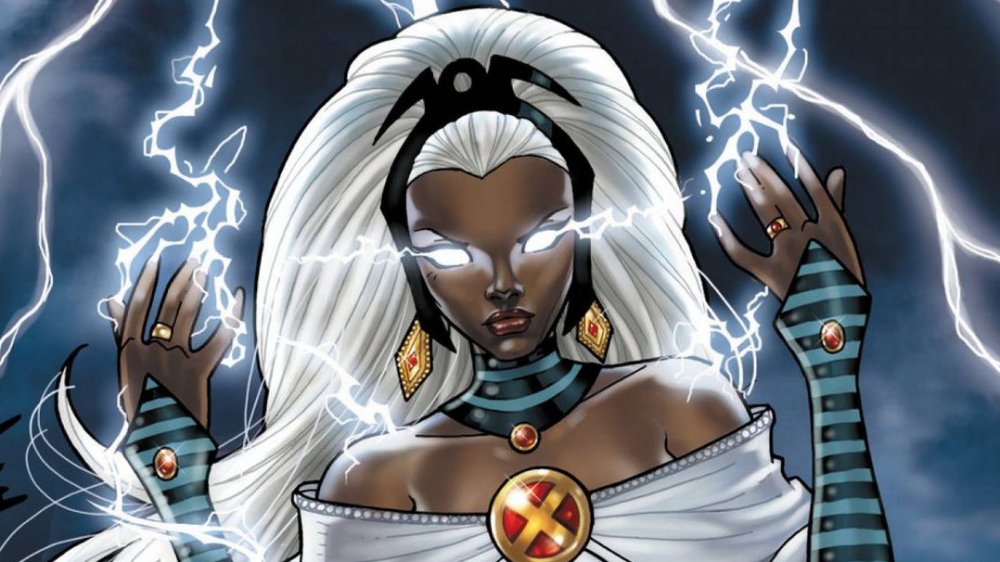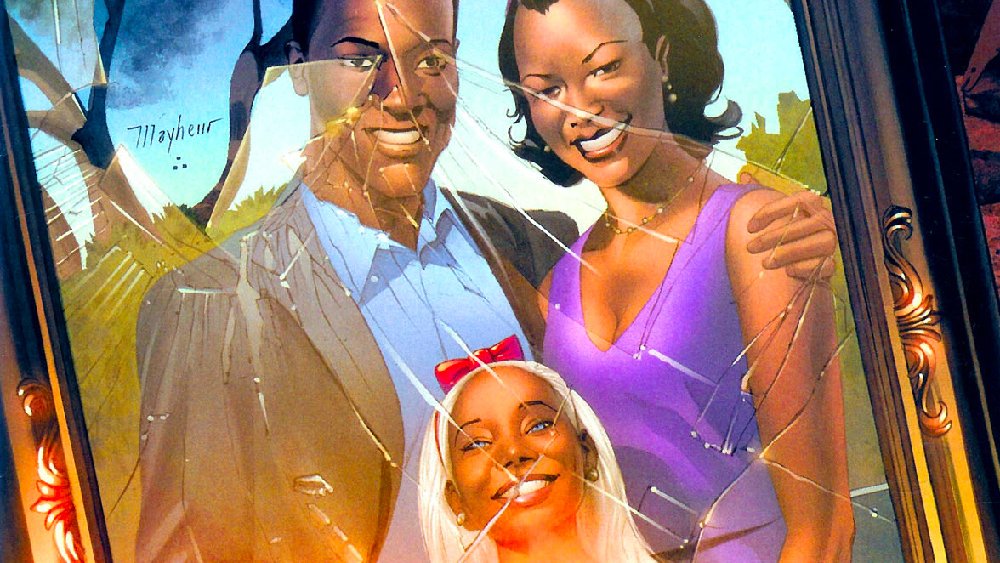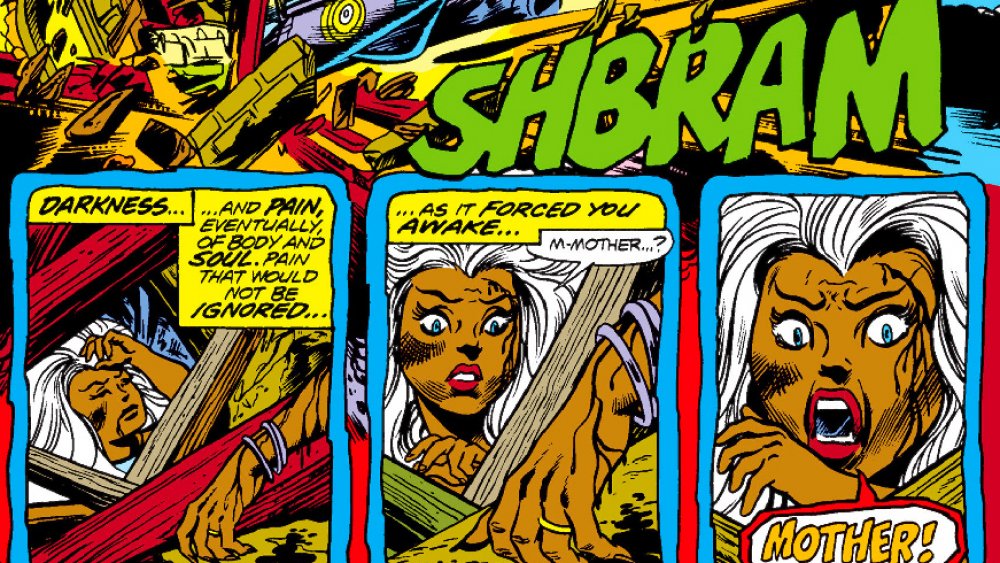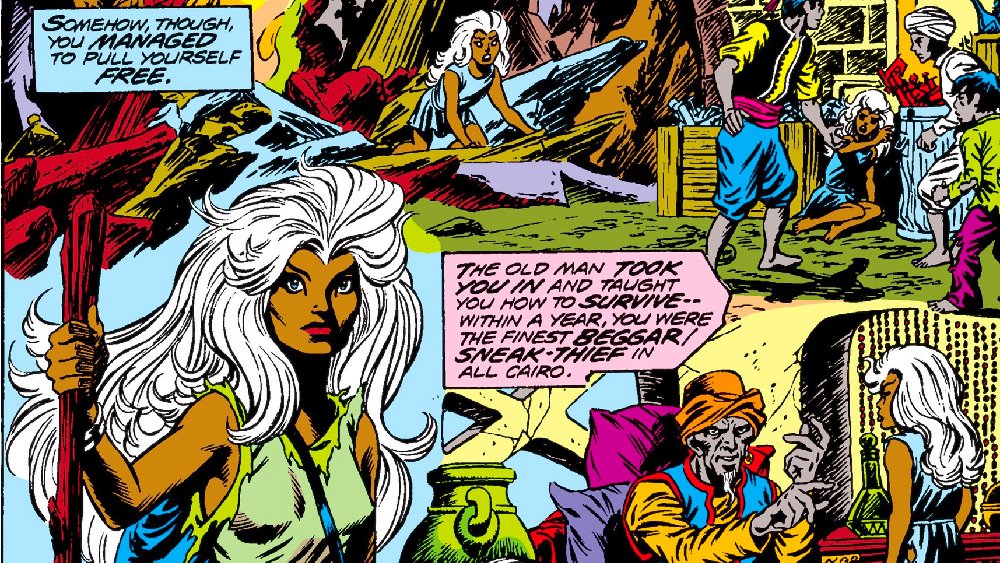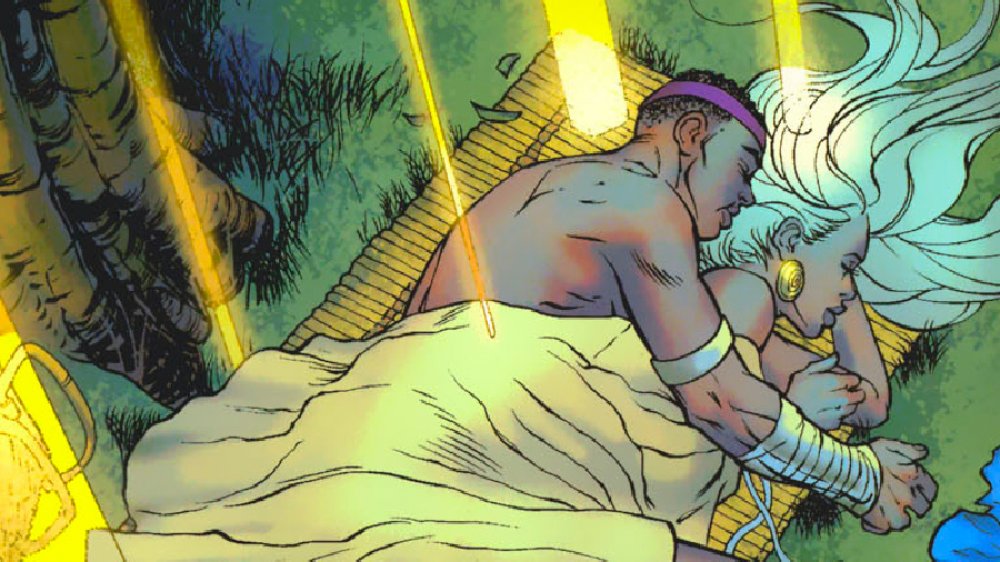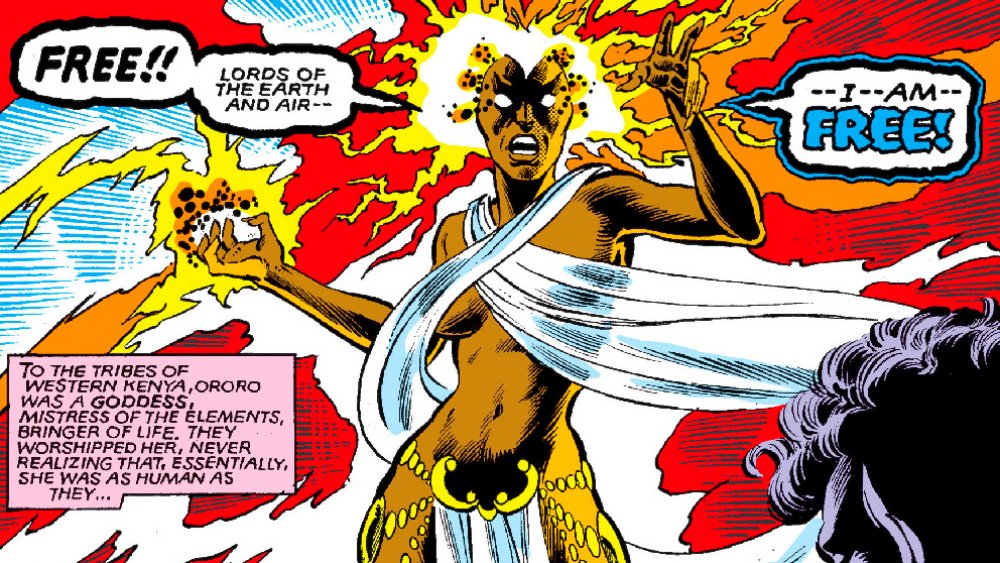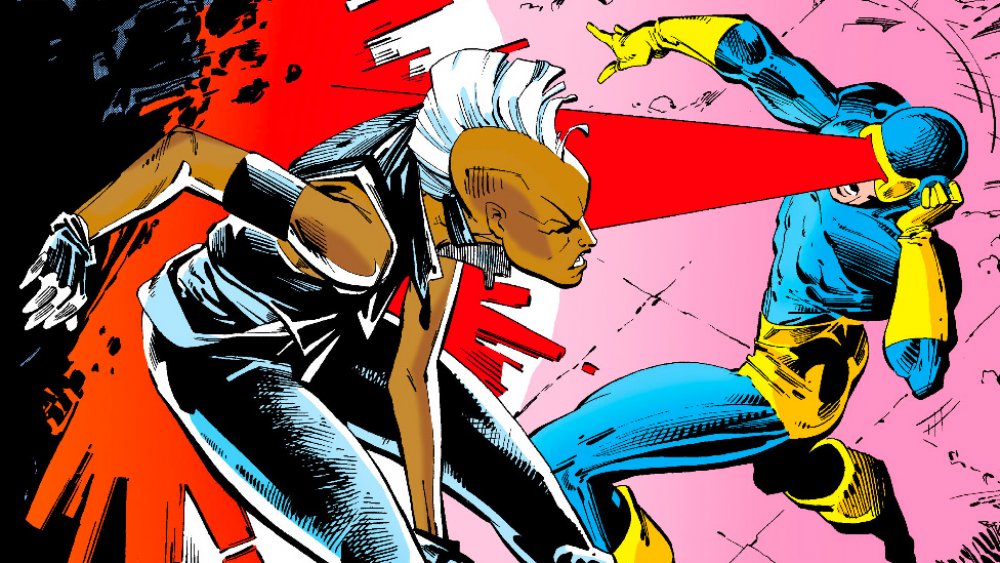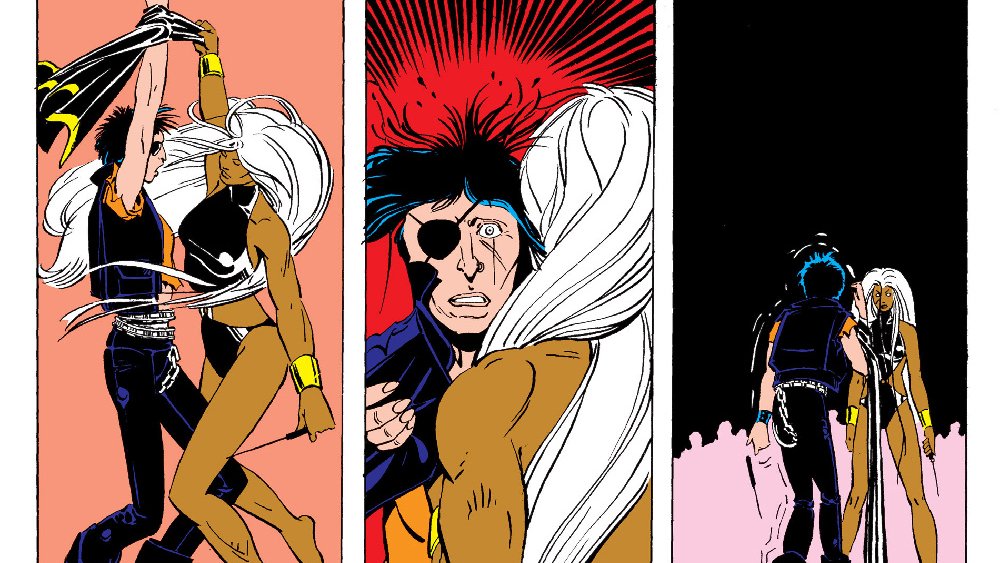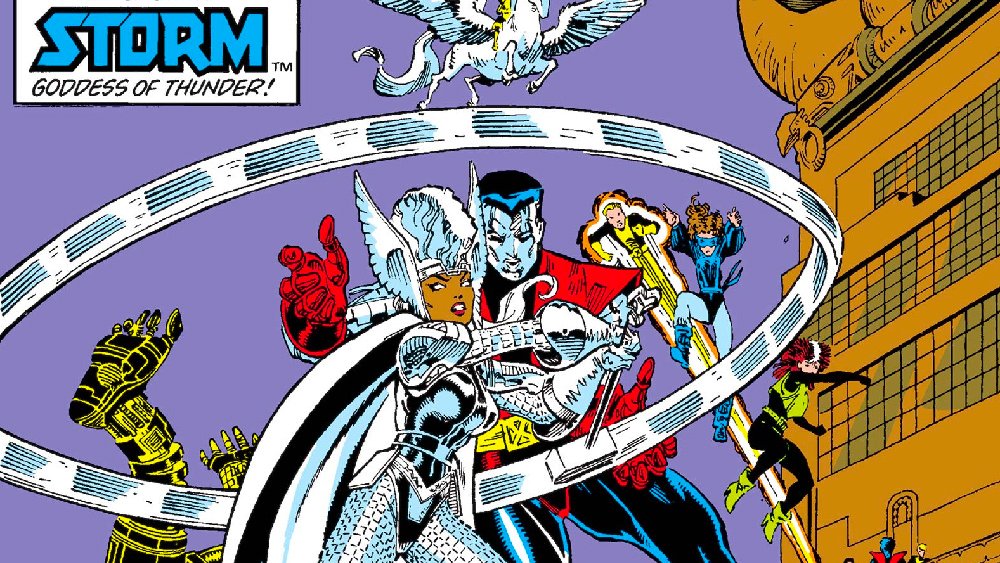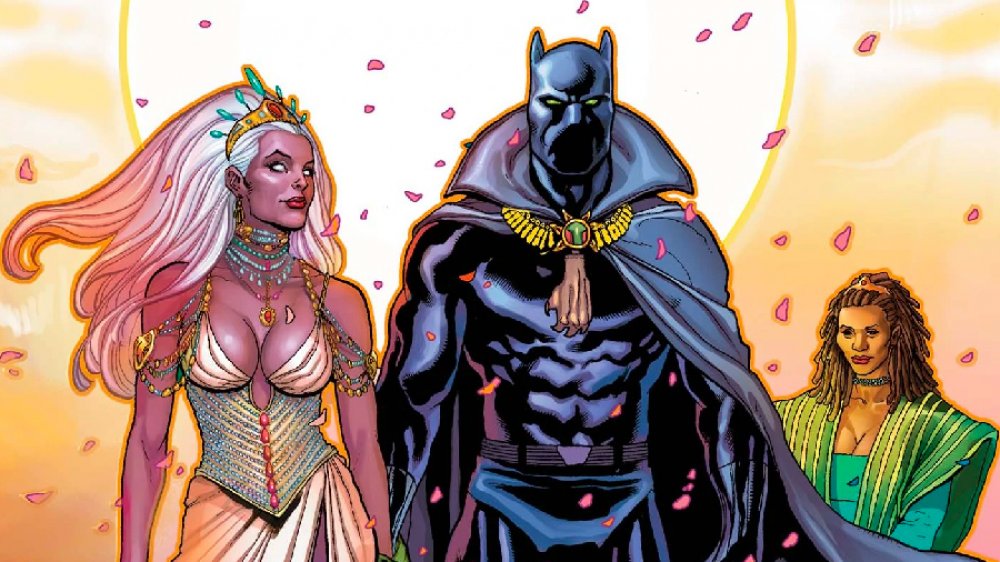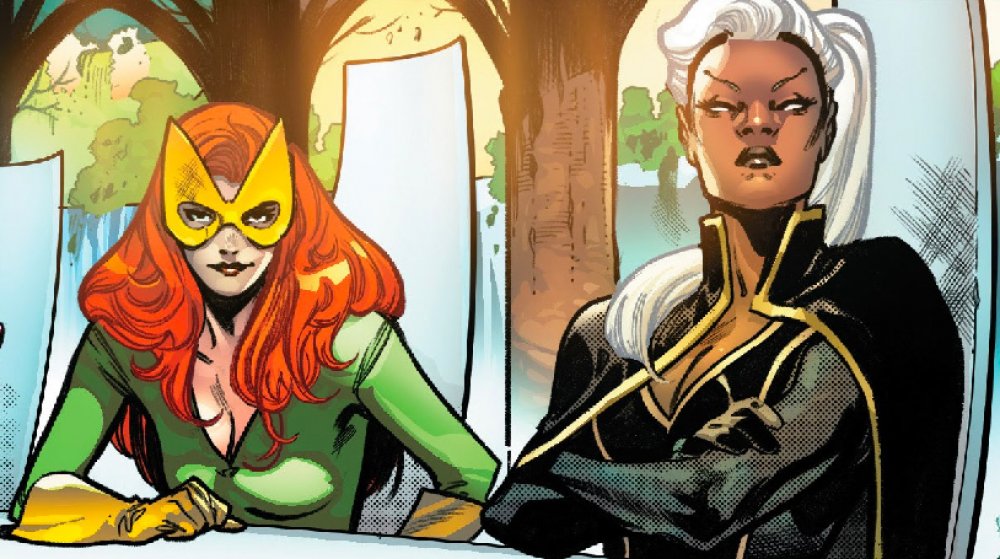Storm's Entire Backstory Explained
Of the dozens of Marvel Comics characters who can claim membership in the X-Men, there are very few who possess the sheer power that Ororo Munroe commands as Storm. She wields absolute power over the weather itself, with the ability to do everything from targeting pinpoint lightning strikes to creating full-on hurricanes to just making sure that it's sunny with a light breeze on Jean Grey's wedding day.
But while most mutants' stories begin when their mutant powers manifest and hit their high point when they join up with Charles Xavier's slightly culty team of feared and hated heroes, Storm has the kind of life that even Wolverine would think is pretty complicated. From her childhood journey as a street urchin to becoming a superhero and street fighter to the times (yeah, more than once) that she's become a god, here's the entire backstory of Storm, one of Marvel's greatest characters.
The story behind Storm's parents
Like many of us, Ororo Munroe's story begins with her parents. Her father was David Munroe, a photojournalist from New York City whose job took him all over the world. That's a nice, normal career, especially by the standards of a universe where the most notable journalist has radioactive spider-powers and spends most of his time fighting a man with robot tentacles stuck to his back.
Ororo's mother, on the other hand, had a far more interesting past. In X-Men #102, N'Daré Munroe was referred to as an "African princess," with all the specificity about her culture that you'd expect from a comic book published in 1976 — which is to say, none. Years later, we'd get a few more details. It would eventually be revealed that N'Daré and Ororo were descendants of a priestess named Ayesha, who wielded magic so powerful that she was thought to be the ancient world's Sorceress Supreme, her era's equivalent of today's Doctor Strange. While Ororo's powers were definitely the result of the X-gene, that mystical heritage would shape both how she was perceived by those around her and how she was able to draw power from them in her later years.
N'Daré would meet David while she was in America, and the two would fall in love and be married before giving birth to their first and only daughter. Eventually, having grown tired of dealing with the racism and the tension that was only being exacerbated by the emergence of mutants, N'Daré would encourage David to take a job covering a conflict in Egypt, and they would move to Cairo with their six year-old daughter in tow. Sadly, that's where tragedy would strike.
Storm's greatest fear
X-Men #102 pins Storm's origin story to the real-life Suez Crisis in 1956. At the time, that made perfect sense, making Ororo a 25-year-old superheroine. But here we are, 45 years later, and she's maybe in her early 30s. That's a pretty clear example of how tying origin stories to real-world events can get confusing if your characters are successful enough to stick around for a while. But really, the details of the conflict around them aren't that important. All that really matters is that the Munroe family went to Cairo so that David could cover a military conflict that came too close to home. Like, way too close. Explosively close.
When Storm was only six years old, a fighter jet was shot down over Cairo, and in the kind of bad luck that seems to plague Marvel's merry mutants, it crashed directly into the Munroes' home. The disaster killed both David and N'Daré, and while Ororo survived, she was left buried underneath the rubble. When she awoke from being knocked out, she realized that she'd been buried alive with her parents' dead bodies, passing out again before waking up to dig herself out, a torturous process that took three days.
As you might expect, this was an incredibly traumatic event for the young mutant, leaving her with an intense claustrophobia that would plague her throughout her adult life. Even as a member of the X-Men, the idea of being buried alive would remain her greatest fear, and it would stand as one of her very few weaknesses, causing her to be paralyzed in horror even in the heat of battle. Eventually, after working through it, the fear would become less intense, but she still definitely prefers being out in the open.
Before she was a superhero, she was a thief
After fleeing from the site of her parents' deaths, and presumably being thought dead herself in the carnage that followed the crash, Ororo found herself homeless on the streets. Fortunately — for certain definitions of "fortunate" — she was taken in by someone who not only gave her a home but taught her a skilled trade that would provide for her in the present and come in handy in her future career as a super-powered adventurer.
Unfortunately, that person was Achmed El Gibár, and the trade in question was thievery. Achmed was essentially Cairo's equivalent of Fagin from Oliver Twist, a thief who employed an army of pickpocketing urchins to gather up ill-gotten goods, primarily pilfered from Cairo's many tourists. Storm, whose brilliant mind was already on display even at a young age, was a natural, and she took to the trade so quickly that she soon became one of Ahchmed's most skilled proteges. Even once she'd left the life of petty crime that marked her youth behind, she'd continue to use those experiences. For example, her costume is often portrayed as having a hidden set of lockpicks, tools that are especially useful for someone with a particular distaste for being trapped.
In the kind of coincidence that happens a lot for the X-Men, one of the tourists unlucky enough to have his pocket picked by Ororo was, of course, Charles Xavier. Naturally, she didn't get away with this one — mind-readers are, after all, pretty difficult to trick — but despite the fact that he immediately recognized her as a mutant, Xavier didn't offer to take her in and train her to be part of his first class of X-Men. Instead, he was distracted by Cairo's reigning criminal kingpin, Amahl Farouk, who was serving as the human host for the sinister villain called the Shadow King, one of Marvel's scariest villains. Both Xavier and the Shadow King took notice of Ororo at this time, with the Shadow King marking her as a potential victim and tool for future evil and Xavier filing her away as a potential recruit.
The romance between Black Panther and Storm
After spending years as a thief on the streets of Cairo, Ororo decided to leave the city, feeling what's usually described in the comics as an irresistible urge to wander south in search of her mother's homeland. The trip took her across the Sahara desert, and while she didn't initially find a new home, she did find someone else who was exploring the world for the first time.
His name was T'Challa, and as you may already know, he would grow up to become the Black Panther. Before he could take up the Black Panther identity and become a king, though, he had to go through a rite of passage, doing his own bit of wandering outside Wakanda as a teenager. While he was doing that, he stumbled across a young girl who was being kidnapped, and after he rescued her, she turned the tables, rescuing him by using her brand new mutant abilities to control the weather.
Over the next few weeks, Ororo and T'Challa would quickly fall in love and begin the kind of passionate romance that only two super-powered teenagers with zero parental supervision can have. Sadly, it didn't last. While their feelings for each other were still very strong, T'Challa's duty to Wakanda came first, and he eventually had to return to his homeland alone. This wouldn't be the last time they encountered each other, though, and it definitely wouldn't be the end of their romance.
That time she was a goddess
After her brief adventures with the future Black Panther, Ororo would finally make it to her mother's home in Kenya, where she was taken in by a woman named Ainet. Ainet would develop a very close bond with the young mutant, and she would regard her as a daughter until she died. Everyone else in their village, however, regarded Ororo as something very different — a literal goddess.
It's not hard to imagine why. By this point, Ororo's powers had fully manifested, and even without any training, her innate control over the weather was a staggering sight to behold. Perhaps surprisingly, worshiping a teenager as a god actually worked out pretty well for everyone involved. Even though Ororo came to believe it herself, she used her powers benevolently, helping out not just the group that had taken her in but the entire surrounding area.
Eventually, of course, someone came along to tell her differently. Charles Xavier, having lost his original students after sending them on a mission to the living island of Krakoa — and having secretly lost a second team that he sent after them, which we wouldn't find out about until 2006 — was putting together a new group of mutants for a rescue mission. Thanks to plenty of people talking about the living goddess who was controlling the weather, he didn't have any trouble tracking down the kid he'd met in Cairo all those years ago. He informed her that she wasn't, in fact, a goddess (rude) but a mutant, and that her powers could be better used by blowing up giant purple robots with lightning bolts. Shockingly, Ororo agreed, and she took the codename Storm as a member of the all-new X-Men.
Becoming the leader of the X-Men
While she initially had a little bit of difficulty fitting in with the other X-Men (largely due to the fact that she kept walking around without any clothes on), Storm quickly acclimated to a life of superheroics as the most powerful member of the team. In fact, after Cyclops left the X-Men after Jean Grey was executed on the moon for the crime of planetary genocide — you know, X-Men stuff — Storm was named the leader, without any argument from the rest of the team.
Sadly, Storm's initial tenure as leader was marked largely by stories about various supervillains having a crush on her, notably including Doctor Doom and Dracula — yes, Dracula — and Ororo having to rebuke their unwanted affections. Doom, as you might expect, didn't respond well to this, and he tried to control Storm by trapping her in her own body via turning her into "living chrome," which triggered her claustrophobia to the point that she conjured up a hurricane that nearly wiped Latveria off the map. Dracula didn't fare much better in the "romance" department, but he did succeed in briefly turning Storm into a vampire in an attempt to make her his latest bride. The curse was broken by Kitty Pryde, but it did lead to stories of another reality where Storm went full-Twilight on everyone, taking the admittedly over-the-top but still pretty awesome new name of "Bloodstorm."
Beyond those incidents, and an unfortunate tendency towards stories where she lost her powers for some reason, Storm's time as the leader of the X-Men featured plenty of character development that forged her into one of the most competent and respected leaders in the Marvel Universe. In fact, she retained leadership of the team when Cyclops returned, and years later, she managed to defeat him in a battle to determine who would lead, all while she didn't have her powers. Pretty impressive by any measure.
Storm is pretty skilled when it comes to knives
Storm's natural talent for leadership didn't end with the X-Men. In Uncanny X-Men #169, Kitty Pryde — the young mutant that Storm had formed a sisterly bond with, to the point of her love for Kitty was what allowed her to just stop being a vampire — was kidnapped. The culprits were the Morlocks, a group of mutants who, in contrast to the X-Men (who are ridiculously attractive even when they're covered in blue fur), had mutations that left them shunned by society.
Like the H.G. Wells characters that inspired them, the Morlocks lived underground, specifically in the sewers of New York City. But unlike NYC's other most famous sewer-dwellers, they were less interested in pizza than in kidnapping 13-year-olds and forcing them into marriage, which is what they wanted with Kitty. Storm and the rest of the X-Men were understandably creeped out by that and decided to put an end to it, but fighting the Morlocks on their home turf proved to be a little more difficult than they expected, and the team was captured. In order to save Kitty and the rest of the X-Men, Storm had to challenge Callisto, leader of the Morlocks, on the villain's own terms. The result was a no-powers switchblade street fight to the death, with Storm still suffering from the effects of Plague, a Morlock with the power to infect her victims with a debilitating disease.
What Callisto didn't know, of course, was that before she was an X-Man, Ororo spent years on the streets, and she was way better at knife fighting than your average superhero. (The look on Callisto's face when Storm effortlessly catches the switchblade that she tosses to her — drawn in Uncanny X-Men #170 by Paul Smith — is one of the best depictions in the history of comic books of someone realizing that they've just messed up real bad.) During the fight, Storm used her cape to tie up Callisto's arm — a nice bit of fighting dirty — and then shanked her right through the ribs. After puncturing a lung, Storm left Callisto to die on the filthy sewer floor while she walked away in stone-cold silence. It gave Storm the respect of the Morlocks (and Callisto, who narrowly survived thanks to some super-powered healing), but more importantly, it served as a reminder that Storm wasn't someone to be messed with.
That time she was a goddess (again)
Storm's tendency to have her powers taken away was certainly an unfortunate one, but to be entirely fair to longtime X-Men writer Chris Claremont, it's at least a little understandable when you consider it from a storytelling aspect. It's very difficult to create tension and danger if your story features someone who has godlike weather control powers, knife murder skills, and willpower so intense that she can just stop being a vampire sometimes. The bright side, though, is that Storm being temporarily depowered actually led to a few of her most iconic moments. One, of course, was beating up a fully powered Cyclops to take leadership of the X-Men. The other is when she briefly became the goddess of thunder, complete with a magic Asgardian hammer.
As you might expect, this was all part of a plot by — who else? — Loki, who was once again attempting to to embarrass and/or murder Thor. After kidnapping a depowered Storm while she was hanging out with the New Mutants, Loki created a magic hammer named Stormcaster and gave it to Ororo. Like Thor's Mjolnir, Stormcaster allowed Ororo to transform into an armored Asgardian form, and it not only restored her ability to control the weather, but Stormcaster granted her all of Thor's other considerable abilities, as well.
While Storm was briefly tempted to abandon Earth and re-embrace godhood, potentially ruling over Asgard alongside Loki, Storm realized that the guy so evil that his very existence prompted the Avengers to get together was probably not on the level. She destroyed Stormcaster with its own power, but the hammer's story wasn't quite over. Like many elements of Marvel's take on Norse mythology, Stormcaster seemed to be bound to a cycle of death and rebirth. It returned (and was destroyed again) on multiple occasions, each time granting Storm thunderous powers on top of her own.
The wedding of Storm and Black Panther
Years after they first fell in love on their respective journeys of self-discovery, Ororo Munroe and T'Challa of Wakanda would find each other again thanks to their prominence in the small — and extremely coincidental — world of superheroes. This time, though, things were different. Despite having far more intense duties as adults than they ever had as teens — including ruling over one of the Marvel Universe's most powerful nations, in T'Challa's case — the two heroes were far more in control of their lives, and they weren't willing to let circumstances pull them apart.
After a whirlwind romance that took place against the backdrop of the Civil War event — a conflict that led Captain America and Iron Man to be shockingly terrible wedding guests — Storm and Black Panther were married in what Marvel billed as "the Wedding of the Century." With that, and a quick journey to another plane of existence where she got the official approval of Bast, the panther god, Storm became the queen of Wakanda. According to Professor Xavier himself, this made her the most important mutant alive. As she was a beloved world-renowned celebrity who was ruling a major nation alongside her husband, Storm was the new face of mutantkind for the average Marvel citizen.
The marriage initially went pretty well, with Marvel's first couple serving as both Avengers and members on a fill-in roster for the Fantastic Four while Reed and Sue Richards were off having marriage problems in another dimension. Storm was even able to continue with her duties as an X-Man, with her international status lending a legitimacy to the team that they'd never really had before.
The breakup of Marvel's most powerful couple
Alas, some things are never meant to last, especially where superhero marriages are concerned. After a conflict between the Avengers and the X-Men in 2012's appropriately titled Avengers vs. X-Men, Ororo and T'Challa found themselves on opposite sides of a conflict centered on the Phoenix. At one point, the Panther named the X-Men as state enemies of Wakanda, which didn't sit well with Storm. The differences became irreconcilable, and the marriage was annulled, freeing Storm to rejoin her original team.
She wasn't done with Wakanda, though, or with the job of ruling over a nation. While T'Challa was otherwise occupied dealing with a time-traveling future version of his country that had conquered most of outer space — you know, comics stuff — Storm returned to Wakanda to help the people, among whom she was still beloved enough to occasionally be worshiped as a goddess (again). This eventually led her to reconcile things with T'Challa, and while their marriage and romantic relationship was still over, they parted on good terms this time.
After the X-Men formed their own separatist nation on the mutant island of Krakoa — which, if you were paying attention above, had its first appearance in the same story that Storm herself did — Ororo was made a member of Krakoa's ruling body, the Quiet Council. The Council was made up of 12 mutants, divided into four factions, named for the seasons. Storm was part of Summer, alongside Jean Grey and Nightcrawler, and she had great success with chartering the laws of their new nation, which is both impressive and surprising when you consider that the council also featured Mister Sinister and Apocalypse.
